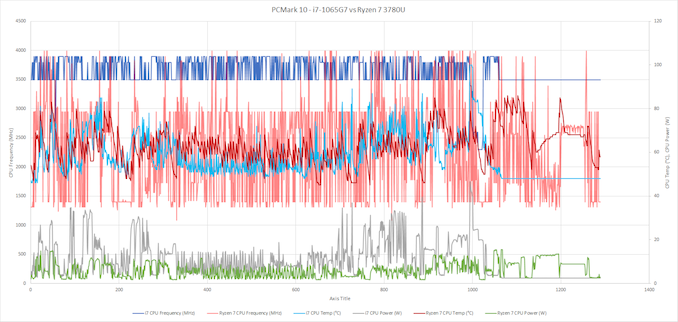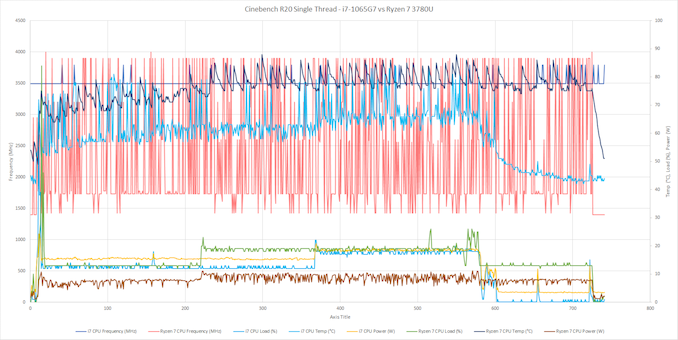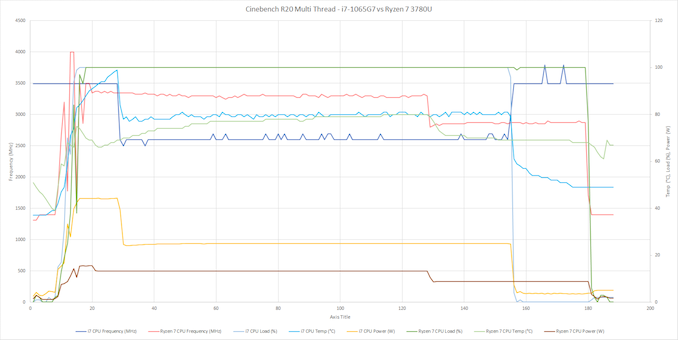The Microsoft Surface Laptop 3 Showdown: AMD's Ryzen Picasso vs. Intel's Ice Lake
by Brett Howse & Andrei Frumusanu on December 13, 2019 8:30 AM ESTBenchmark Analysis: Boost Behavior
Let’s dig into some of the testing to see how the systems responded during the benchmarks. We re-ran several of the tests while simultaneously monitoring the processor frequency, temperature, and power. Unfortunately for our comparison, the power polling results provided by our monitoring tools don’t seem to monitor the same power draw. The Intel power numbers are for the SoC package, but the AMD power numbers appear to be just the CPU cores, which is an unfortunate byproduct of testing two different platforms.
PCMark 10
PCMark 10 is a benchmark platform that attempts to simulate real-world tasks by running a variety of workflow, and the results were perhaps the most interesting of any of the benchmarks. There is a major discrepancy in how the AMD CPU behaved compared to the Intel. The Ice Lake platform kept the CPU frequency at a minimum of 3.5 GHz, with bursts to 3.9 GHz when under load. The Picasso processor was very aggressively switching from low frequency to high frequency, and was rarely indicating that it was over 3.0 GHz, but clearly demonstrating its higher peak frequency of 4.0 GHz in several locations. Both systems were fairly even in terms of CPU temperature, and Intel’s aggressive turbo levels were evident with peak power levels of 40 Watts for brief moments. The Ice Lake platform finished the benchmark about 200 seconds quicker than the Picasso system.
Cinebench R20 Single-Thread
We see somewhat similar results when only a single CPU core is loaded with the Picasso CPU frequency varying quite a bit. There’s also an average higher temperature on the AMD platform during this workload, and once again Ice Lake finishes the rendering quite a bit sooner thanks to its stronger CPU cores.
Cinebench R20 Multi-Thread
With all cores loaded the graph is considerably altered. Here the AMD processor is able to maintain a much higher frequency across its cores for much longer, while Intel's chip is only able to maintain 3.5 GHz for about 30 seconds before it runs out of headroom, dropping the cores down to around 2.6 GHz. But despite the lower frequency, the much higher IPC on Sunny Cove allows the Ice Lake platform to finish quite a bit sooner.













174 Comments
View All Comments
Fataliity - Saturday, December 14, 2019 - link
That came out wrong re-reading it. sorry its late. AMD's die is twice the size which should let it cool better. and apu ccx is 60mm squared, intel's for 4 cores is almost the same on ice lake. So yes a similar power for similar heat would make sense. We don't know what's coolin the inside on both of these either though, that could make a big difference. However, I still think it's questionable when Intel boosts and hits 100 degrees C, just looks like they're pushing the CPU as far as possible to make it look as good as it can, knowing the new APU's are coming out soon.And yes, the fact that it can draw 42 watts on CPU at boost definitely seems like an unfair advantage. The temps also reflect that in 25 seconds it overheats due to it too, forcing to ramp down.
Fataliity - Saturday, December 14, 2019 - link
And I looked into the IO. It should pull 10-15W, including graphics idle, putting Ryzen on par with Ice Lake around 20-25 watts. Which would make more sense.pifaa - Saturday, December 14, 2019 - link
Personal opinion. The review is very obviously biased towards Intel. The tests are carefully sellected to demonstrate Intel dominance, which in the real world is non present anymore. The only advantage Intel still has over AMD in the mobile space, is power consumption. As we see, that advantage is shrinking fast.m53 - Saturday, December 14, 2019 - link
Personal opinion. The earth is flat.GruenSein - Saturday, December 14, 2019 - link
The results are no surprise. It’s Intel‘s newest architecture and manufacturing node against AMD‘s year old Zen1+ on 12nm. It’s too bad that AMD take their time updating mobile parts and APUs. A Zen2 + Navi on 7nm should be much more competitive. This is the inverse situation we see in desktop parts where there is no sunny cove and still 14nm for Intelyeeeeman - Saturday, December 14, 2019 - link
Lets see what AMD brings to the table with zen 2. Intel does have a better ipc with ice lake, even compared to zen 2, but it has a handicap in the fact that it is built on 10nm and they have only 4 cores in 15w tdp. I am pretty confident that AMD can afford a 6 core in the same tdp, like comet lake.dragosmp - Saturday, December 14, 2019 - link
The boost behavior is very erratic on the AMD. I assume this ramping up/down under load is quite inefficient and buts a high emphasis on how fast the CPU can ramp up and down.Looks very erratic to the point of being defective. Multi-core loads though are fine. Does this mean when a low-threaded task is ran the scheduler bunny hops the task on all cores? This used to be a problem on Ryzen1 and thought it was solved with an AMD driver, but it came back maybe on this MS product.
I suspect a few % performance were left on the table, but like most here I assume the GPU is bandwidth-starved and high speed memory can't come soon enough for AMD. Quite surprising how poor they are with feeding the GPU, lack of dev on the GPU side in the last few years has hurt a lot.
AshlayW - Saturday, December 14, 2019 - link
Awesome result for the Ice Lake chip. But let's keep expectations in check here; the Ryzen part is based on a uArch from 2017 with slight optimisations, and also has half the L3 cache size due to a significant process disadvantage. While a very valid product v product comparison it is not particularly 'fair' as Intel's development (sunk) costs for the ICL and 10nm node are astronomically higher than Picasso's.I consider this 'flavour' until AMD can finally pull its finger out of its rear and get Zen2 mobile cores on 7nm, which should match or beat this. Finally, the memory limitation on the Picasso part is severely holding it back. I have no idea they wouldn't have opted for DDR4-2933 (what Picasso supports natively), which can lower its clock rate in less demanding tasks for higher efficiency. In some of these tests, this could have allowed AMD the win (which would have been particularly impressive given the huge aforementioned uArch/Node advantages Intel has). The bandwidth would have especially helped in the graphics tests. If the AMD surface design is significantly cheaper (I am willing to bet AMD can give these chips for 25% of what Intel is selling the ICL for) it could slot nicely in as a lower performing, but also much lower cost alternative.
I will wait patiently for Renoir to see what 7nm Zen2 can do in mobile; arguablly where it is most needed.
scineram - Monday, December 16, 2019 - link
I think they worried about power with faster memory.MBarton - Monday, December 30, 2019 - link
profit margin limited and not enough leftover Zen 2 after satisfying Epyc orders, THR3/Ryzen 3k, and console orders.